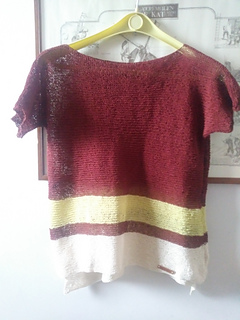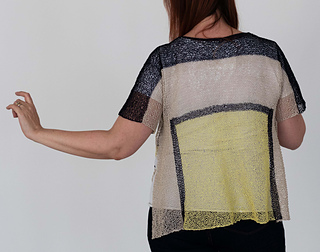patterns >  Artherapy
Artherapy
> Far Horizons



















Far Horizons
Pattern available in English and Italian.
In collaboration with ITO yarn company, I’m very happy to release “Far Horizons”.
Click here to see 5 ways to wear Far Horizons!!!
“Far Horizons” is a loose fitting t-shirt that is knit flat in one piece and then sewn up.
Its unusual shape is due to the fact that the front is narrower than the back and to the sleeve seams that continue along the armholes.
We start knitting the front in wide, garter stitch stripes, followed by a section in just one of the colours.
The sleeve stitches are cast on at the underarms.
The stitches at the center of the piece are bound off to shape a boat neckline and the work continues on the back of the sweater; at a certain point another colour is added. Then the sleeve stitches are bound off and work continues on the back, which features an interesting intarsia motif. The back of the sweater is longer than the front.
Finally, the sleeves and underarms are sewn in a contrasting colour.
Finished measurements - Onesize:
Bust circumference: 120 cm – 47 ¼ in.
Neck circumference: 50 cm – 19 ¾ in.
Length: 32 cm – 12 ½ in from underarm measured along the front side; 37 cm – 14 ½ in from underarm measured along the back side.
Sleeves length: 10 cm – 4 in from underarm.
Shown worn with bust size 96 cm – 37 ¾ in and with 24 cm – 9 ½ in of positive ease.
Gauge:
16 sts and 30 rows = 10 cm – 4 in in garter stitch (after blocking).
Yarn and needles:
ITO Gima (Lace yarn; 100% cotton; 211 m – 231 yd/25 g – 0.88 oz. ball).
First colour (FC): 627 Rainy Day; 2 balls (286 m – 313 yds);
Second colour (SC): 625 Navy; 3 balls (422 m – 462 yds);
Third colour (TC): 626 Lime 1 ball (160 m – 175 yds).
Note: the number of meters indicated is less than the suggested number of balls of yarn. This is due to the intarsia motif.
Needle size 3 mm – US 2.5.
Adjust needle size if necessary to obtain the correct gauge.
Other:
Tapestry needle and scissors.
Pins and a tape measure for blocking.
…………………………………
Pattern disponibile in italiano ed inglese.
In collaborazione con l’azienda ITO, sono molto contenta di presentare “Far Horizons”.
Clicca qui per vedere 5 modi di indossare Far Horizons!!!
La maglietta “Far Horizons (Orizzonti Lontani)” ha una linea molto comoda ed è lavorata in piano e poi cucita.
Ha una forma particolare ottenuta dal fatto che il davanti è più stretto del dietro e le due parti sono tenute insieme dalla cucitura in corrispondenza delle maniche che continua in corrispondenza dello scalfo.
Si incomincia a lavorare la parte davanti a grandi righe a maglia legaccio, continuando in seguito con un solo colore.
In corrispondenza degli scalfi, si montano le maglie per le maniche.
Si chiudono le maglie al centro del lavoro per formare uno scollo a barchetta e si prosegue il lavoro sul dietro della maglietta, inserendo ad un certo punto un altro colore.
Si chiudono, quindi, le maglie delle maniche e si prosegue con il dietro, lavorato con un interessante motivo ad intarsio e più lungo del davanti.
Alla fine si cuciono le maniche e gli scalfi, usando un filo di colore contrastante.
Misure finite – Taglia unica:
Circonferenza del seno: 120 cm.
Circonferenza del collo: 50 cm.
Lunghezza: 32 cm dallo scalfo misurati lungo la parte davanti; 37 cm dallo scalfo misurati lungo la parte dietro.
Lunghezza delle maniche: 10 cm dallo scalfo.
Le foto si riferiscono alla maglietta indossata da una modella con un giro seno di 96 cm e con un agio di 24 cm.
Campione:
16 m x 30 f = 10 cm lavorati a maglia legaccio (dopo il bloccaggio).
Filato e ferri:
ITO Gima (100% cotone; 211 m per gomitolo da 25 g).
Primo colore (PC): 627 Rainy Day; 2 gomitoli (286 m);
Secondo colore (SC): 625 Navy; 3 gomitoli (422 m);
Terzo colore (TC): 626 Lime; 1 gomitolo (160 m).
Attenzione: il quantitativo del metraggio indicato è inferiore al numero dei gomitoli consigliati. Ma questo è necessario per la lavorazione ad intarsio.
Ferri circolari numero 3 mm.
Se necessario modificare il numero dei ferri per ottenere il campione corretto.
Altro:
Ago da lana e forbici.
Spilli e metro da sarta per il bloccaggio.
Photo courtesy: Paolo Bonivento
English traslation: Donna Lynne Galletta
Grazie alla mia tester Tiziana!
1481 projects
stashed
1485 times
- First published: April 2019
- Page created: April 1, 2019
- Last updated: September 25, 2022 …
- visits in the last 24 hours
- visitors right now





